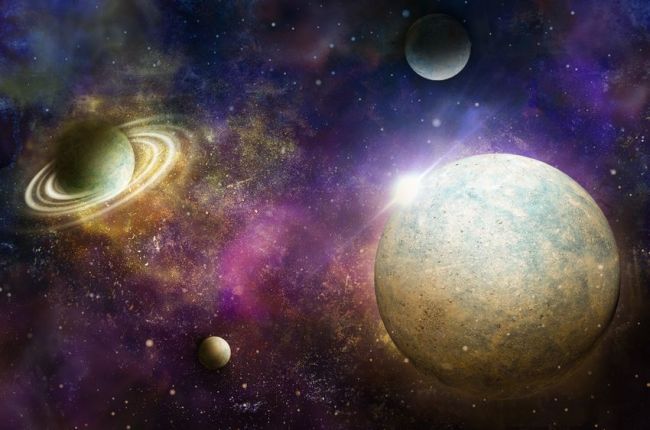Comet dust may have seeded Jupiter's moons, including Europa and its liquid ocean beneath an icy crust, with the raw ingredients for life, U.S. researchers say.
Asteroids and comets rich in the carbon-containing compounds that are key to life on Earth have been captured by Jupiter's gravity, becoming orbiting moons that frequently collided as they settled into new orbits billions of years ago and created a fine dust of those compounds, they say.
The question is, where has all that dust gone?
Computer models suggest Jupiter should have captured about 70 million gigatons of rocky material but less than half that amount remains as irregular moons orbiting the planet.
William Bottke of the Southwest Research Institute in Boulder, Colo., said the ground-up material would have fallen toward Jupiter, dragged by gravity and blown by the solar wind and almost half of it would have hit Jupiter's largest moons, including Callisto, Ganymede and Europa.
Images from NASA's Galileo spacecraft have shown dark material on Ganymede and Callisto.
"Callisto literally looks like it's buried in dark debris," Bottke told NewScientist.com, noting the surface of Ganymede looks similar.
In comparison, Europa's surface appears relatively clean but cracks in the moon's icy crust suggest material is being cycled from the surface to deeper inside.
Carbon-rich debris settling on Europa may have been incorporated into the ice and made it into the ocean, Bottke said.
"Would it be important in Europa's ocean? It's hard to say," he said. "But it is kind of interesting to think about." (UPI)
<관련 한글 기사>
‘혜성먼지’, 우주에 생명의 씨앗 뿌리나?
혜성에서 나오는 먼지들로 인해 생명의 구성요소들이 우주로 전파된다는 주장이 제기되었다고 UPI통신이 15일 (현지시간) 보도했다.
미국 콜라라도 남서부 연구소의 행성학 전문가 윌리엄 보트케 박사는 생명의 기본적인 구성요소로 작용하는 물질들이 이러한 ‘혜성먼지 (comet dust)를 통해 유로파 등 목성의 위성들에 전파됐을 가능성이 있다고 주장했다.
혜성이나 소행성은 지구상의 생명이 존재하게 하는 필수요소인 탄소물질을 다량으로 함유하고 있으며, 이러한 천체들은 태양계를 지나던 도중 목성의 중력에 사로잡혀 행성 주위를 공전하게 된다.
하지만 이런 식으로 목성 주위를 도는 천체들의 총 질량은 애초에 목성에 사로잡힌 7천만 기가톤 분량의 암석들에 비하면 절반밖에 되지 않는다고 한다.
보트케 박사는 이러한 소행성이나 혜성들이 서로 충돌하면서 생긴 먼지, 즉 목성 주위를 공전하는 천체가 되지 않은 물질들이 중력에 이끌려 목성 쪽으로 오다가 칼리스토, 가니메데, 유로파 등 목성의 대형 위성들에 떨어졌을 것이라고 추정했다.
미항공우주국 (NASA)의 이미지 역시 가니메데와 칼리스토에 있는 어두운 색의 물질들을 보여주고 있다.
박사는 “칼리스토는 말 그대로 어두운 색의 물질에 묻혀 있는 것처럼 보인다”라며 가니메데의 표면 역시 비슷하다는 점을 지적했다.
유로파의 표면은 비교적 깨끗해 보이지만 그는 이러한 먼지들이 행성을 덮고 있는 얼음 표면에 난 틈을 통해, 위성 아래에 있을 것으로 추정되는 액체 바다로 흘러갔을 것이라고 추정했다.
보트케 박사는 탄소가 다량 함유된 파편들이 얼음에 포함되어 바다로 흘러갔을 수도 있다고 말했다. (코리아헤럴드)




![[Exclusive] Korean military set to ban iPhones over 'security' concerns](http://res.heraldm.com/phpwas/restmb_idxmake.php?idx=644&simg=/content/image/2024/04/23/20240423050599_0.jpg&u=20240423183955)

![[Graphic News] 77% of young Koreans still financially dependent](http://res.heraldm.com/phpwas/restmb_idxmake.php?idx=644&simg=/content/image/2024/04/22/20240422050762_0.gif&u=)



![[Pressure points] Leggings in public: Fashion statement or social faux pas?](http://res.heraldm.com/phpwas/restmb_idxmake.php?idx=644&simg=/content/image/2024/04/23/20240423050669_0.jpg&u=)









